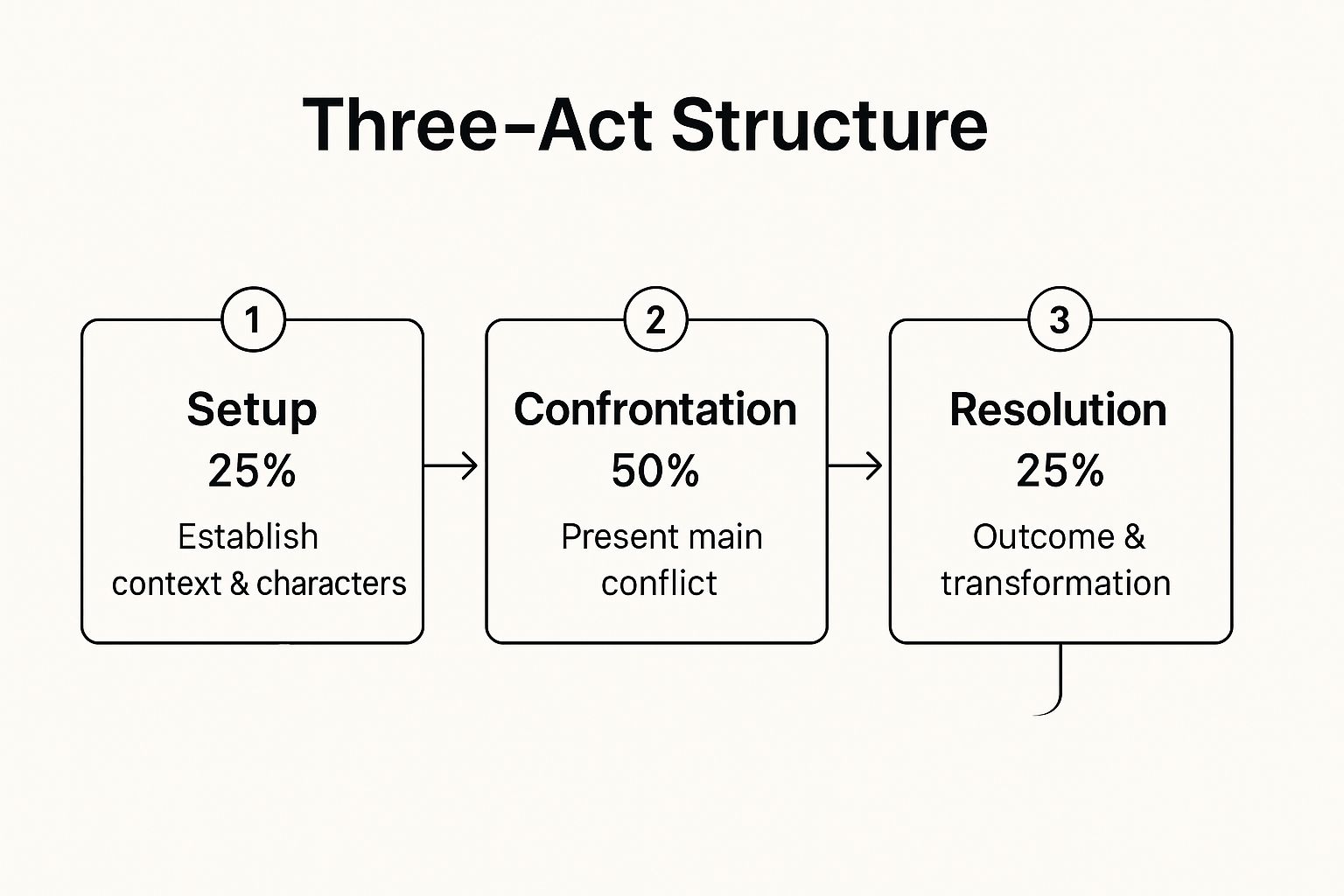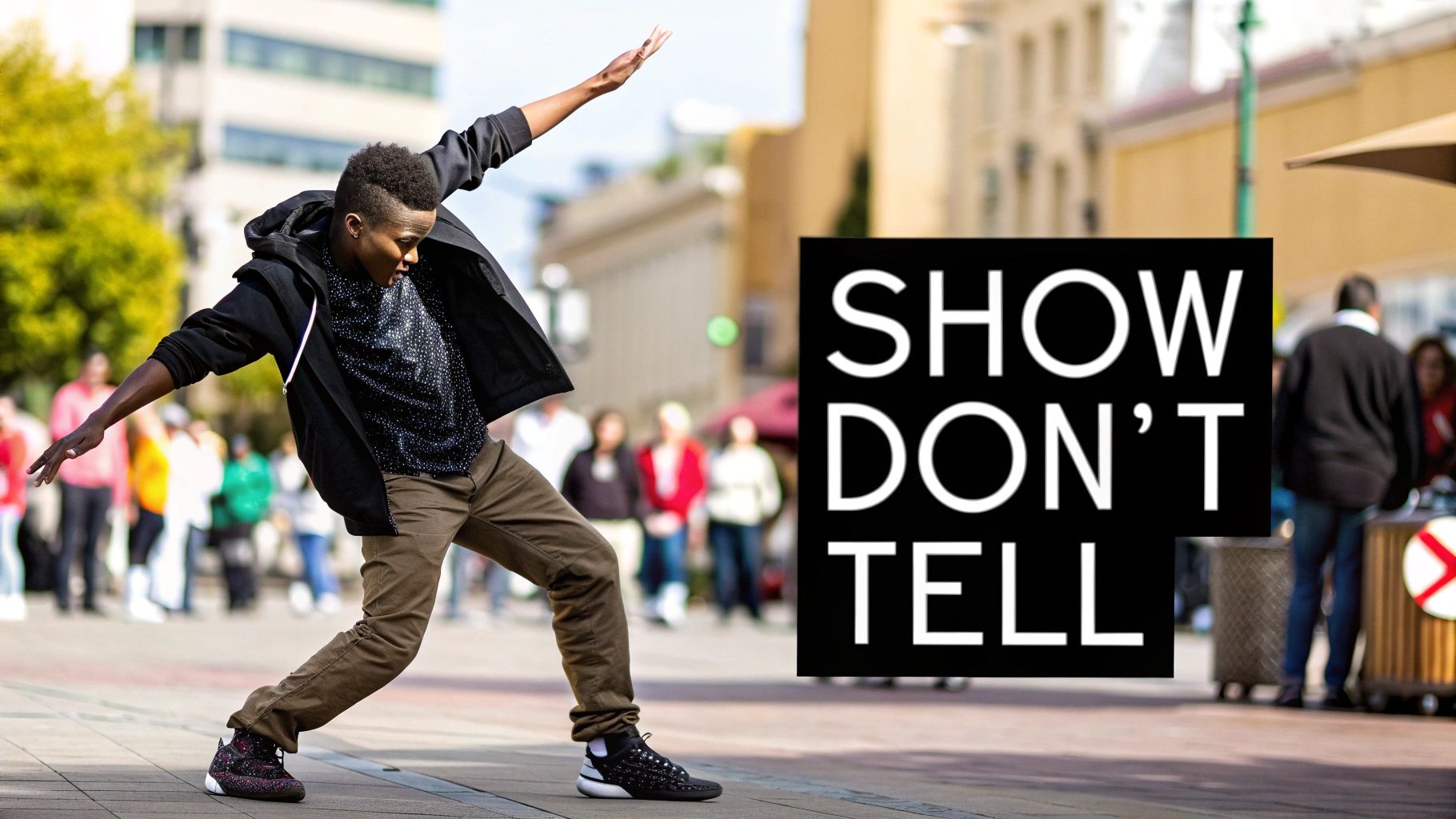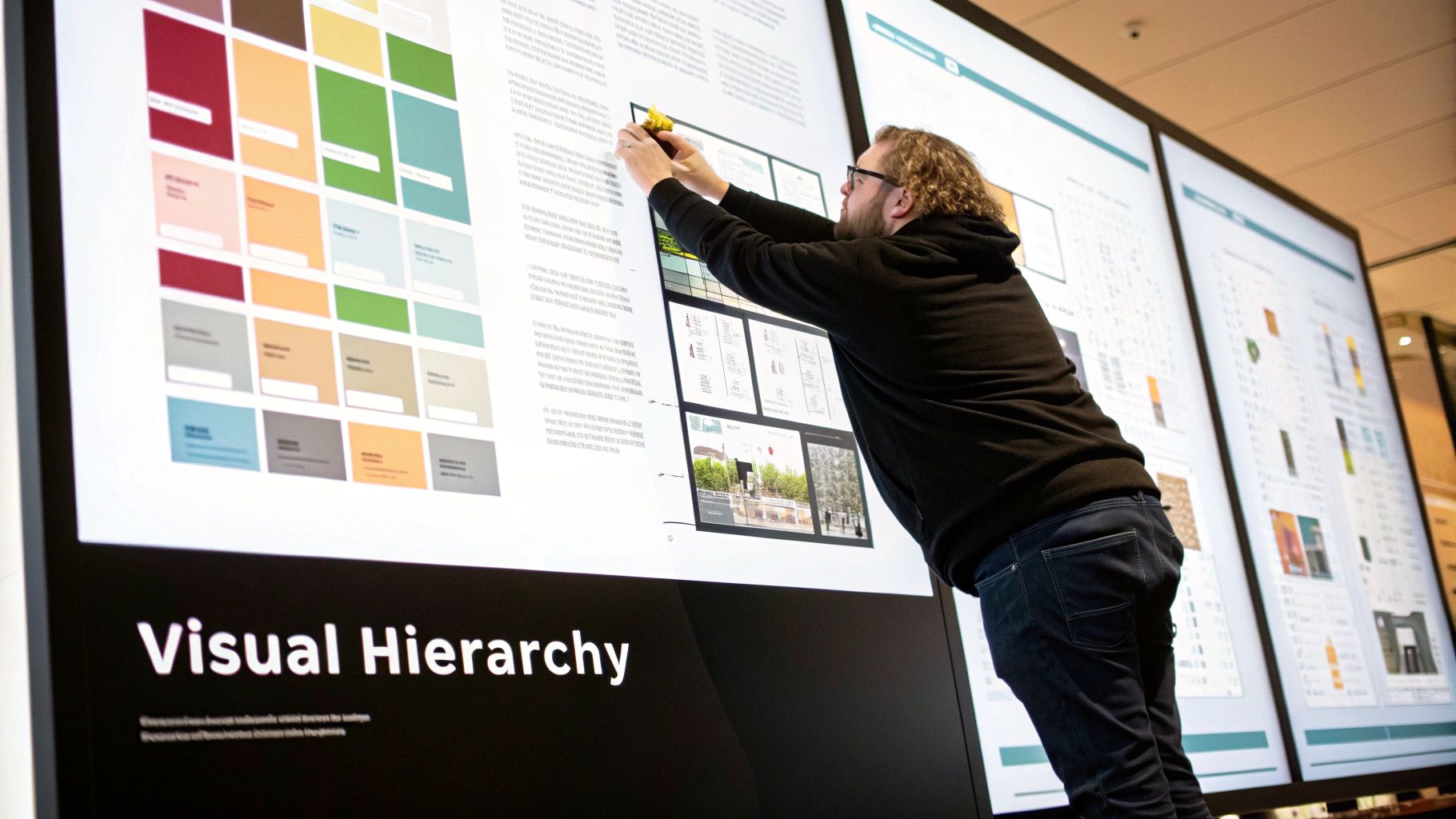A powerful image can stop a user from scrolling, but a powerful visual story can turn them into a loyal follower. The difference lies in intention and technique. Crafting a narrative that resonates requires more than just aesthetically pleasing visuals; it demands a strategic approach that guides the viewer's eye, evokes specific emotions, and communicates a clear message without a single word of text. This is where mastering the art of visual storytelling becomes a critical skill for any creator or marketer. A compelling visual narrative doesn't just display information; it creates an experience that forges a genuine connection with your audience.
This article provides a curated collection of practical visual storytelling tips designed to elevate your content from simple posts to impactful narratives. We will move beyond generic advice to offer actionable strategies you can implement immediately. You will learn how to structure your stories using the classic three-act model, create compelling character-driven content, and use visual hierarchy to direct attention. We will also explore how to develop emotional arcs, adapt narratives across different platforms, and even transform raw data into a compelling visual journey. These techniques will equip you with the tools to build more engaging, memorable, and effective visual content.
1. The Three-Act Story Structure
The three-act structure is a time-tested narrative framework that organizes a story into a clear beginning, middle, and end. Popularized by everyone from Aristotle to Pixar, it’s a powerful tool for visual storytelling because it creates a logical and emotionally resonant journey for the audience. By dividing your visual narrative into three distinct parts, you guide viewers from initial curiosity to ultimate satisfaction.
This structure is ideal for creating compelling product launches, impactful brand campaigns, and engaging documentary-style content. Its universal appeal makes it one of the most effective visual storytelling tips for connecting with any audience.
The Anatomy of the Three-Act Structure
The framework is deceptively simple, allocating specific roles and time to each act to maximize narrative impact.
- Act I: Setup (The Beginning). This is where you establish the world of your story. You introduce the main characters, define the setting, and present the "normal" state of affairs. The goal is to create context and give the audience someone or something to root for before the central conflict is introduced.
- Act II: Confrontation (The Middle). The longest and most dynamic part, this act introduces the core conflict or challenge. Your protagonist faces escalating obstacles, building tension and raising the stakes. This is where the main action unfolds, keeping the audience invested in the outcome.
- Act III: Resolution (The End). Here, the story reaches its climax, the main conflict is resolved, and a new reality emerges. This final act delivers the payoff, showing the character's transformation or the solution to the problem, and provides a clear, memorable takeaway.
The following infographic illustrates the recommended time allocation for each act, providing a blueprint for pacing your visual story.

This process flow highlights that the Confrontation phase should occupy half of your narrative, ensuring there is sufficient time to build tension and explore the central challenge.
2. Show, Don't Tell
The principle of "Show, Don't Tell" is a cornerstone of powerful communication, urging creators to use visual elements, actions, and subtext rather than relying on explicit narration or text. Originating in literary advice from authors like Anton Chekhov, this technique has become one of the most vital visual storytelling tips. It engages viewers on a deeper level by allowing them to interpret scenes, feel emotions organically, and draw their own conclusions, making the narrative experience more immersive and memorable.

This approach is highly effective in advertising, documentaries, and social media content where emotional connection is key. By showing a character's trembling hands instead of saying they are nervous, or depicting a dilapidated room instead of stating a company is struggling, you create a far more profound impact.
How to Implement "Show, Don't Tell"
Applying this principle requires a focus on visual cues and implicit meaning to guide the audience’s understanding and emotional response.
- Emphasize Non-Verbal Cues. Use facial expressions, body language, and gestures to convey emotions. A character's slumped shoulders can say more about defeat than any line of dialogue.
- Leverage Environmental Storytelling. The setting, props, and even the lighting can reveal crucial information about the characters, their history, and the state of their world without a single word.
- Let Actions Drive the Narrative. Instead of telling the audience a character is brave, show them performing a courageous act. The consequences of their actions should speak for themselves, revealing character and advancing the plot.
- Use Visual Metaphors. Abstract concepts like freedom, love, or despair can be represented through powerful visual symbols. Think of a bird taking flight to symbolize liberation or a wilting flower to represent lost hope.
This method builds trust with your audience by respecting their intelligence, inviting them to participate actively in the story rather than passively receiving information. It transforms a simple message into a shared experience.
3. Character-Driven Narratives
A character-driven narrative is a powerful visual storytelling technique that places a relatable character at the heart of the story. Instead of leading with plot, products, or abstract ideas, this approach focuses on a character’s personal journey, including their struggles, motivations, and transformation. This method forges deep emotional connections by giving the audience a person to root for, making the message more memorable and impactful.
This approach is highly effective for building brand loyalty and humanizing complex topics. Campaigns like Always' '#LikeAGirl' and the long-running "Flo" from Progressive Insurance demonstrate how compelling characters can become synonymous with a brand's identity, creating lasting engagement. These visual storytelling tips help turn passive viewers into an active, invested audience.
The Anatomy of a Character-Driven Narrative
Building a successful character-driven story involves more than just creating a mascot; it's about crafting a believable persona that drives the plot forward.
- Establish Relatability: The first step is to develop a character that reflects the target audience's values, aspirations, or challenges. This character doesn’t have to be a literal representation but should embody a core human experience that resonates with viewers.
- Define Motivation and Obstacles: A compelling character needs a clear goal and significant hurdles to overcome. The motivation provides the "why" behind their actions, while the obstacles create the necessary conflict and tension that keeps the audience engaged in their journey.
- Show, Don't Just Tell, Transformation: The narrative should showcase the character's growth. Whether they gain new confidence, solve a difficult problem, or see the world differently, their evolution is the emotional payoff for the audience. This transformation should be demonstrated visually through their actions and expressions.
The following video shows how Apple used a character-driven approach to tell a touching story that subtly highlights its product features, focusing entirely on the character's emotional journey.
4. Visual Hierarchy and Composition
Visual hierarchy and composition are the strategic arrangement of elements to guide the viewer’s eye through a scene in a deliberate sequence. This ensures the most critical parts of your story are noticed first, creating a clear and logical narrative flow. Pioneers of design and film, from the Bauhaus school to Stanley Kubrick, have used these principles to direct attention and evoke specific emotions, making them foundational visual storytelling tips.

This technique is essential for designing effective website layouts, impactful advertisements like Apple's minimalist product photography, and compelling social media content like Netflix's thumbnail designs. By mastering composition, you control the story's pacing and ensure your audience understands the message without conscious effort. For a deeper exploration of this topic, you can learn more about effective composition techniques for photography on ai-media-studio.com.
Core Principles of Composition
Applying a few key principles can dramatically improve the clarity and impact of your visual stories, making them more engaging and professional.
- Rule of Thirds: Imagine your frame is divided by two horizontal and two vertical lines, creating nine equal boxes. Placing key elements along these lines or at their intersections creates a more balanced and dynamic composition than centering the subject.
- Leading Lines: Use natural lines within your image, like roads, fences, or architectural features, to draw the viewer's eye toward your focal point. This creates a clear path through the narrative of your visual.
- Contrast and Scale: Employ strong contrast in color, light, or size to make important elements stand out. Making a subject larger or brighter than its surroundings instantly establishes it as the primary focus of your story.
5. Emotional Arc Development
An emotional arc is the deliberate journey you take your audience on, guiding them from one emotional state to another. Mastered by legendary filmmakers and advertisers, this technique involves strategically using visual and auditory cues to shape the viewer's feelings. It’s not just about telling a story; it’s about making the audience feel the story, creating a deep and memorable connection.
This method is perfect for brand stories, PSAs, and any content aiming to inspire action or build loyalty. By mapping out an emotional progression, like in P&G's "Thank You Mom" campaigns or Google's "Year in Search" videos, you craft a powerful experience that resonates long after the screen goes dark. This is one of the most potent visual storytelling tips for driving genuine engagement.
Crafting a Compelling Emotional Journey
The goal is to create a satisfying emotional experience by carefully orchestrating narrative beats, pacing, and sensory details.
- Map the Journey: Before production, define the emotional path. Do you want viewers to move from curiosity to inspiration, or from concern to hope? This map becomes your blueprint for every creative decision, ensuring a cohesive emotional narrative. For example, a story might start with a feeling of isolation, build to a sense of struggle, and resolve with a feeling of community.
- Leverage Sensory Cues: Music, sound design, color grading, and pacing are your primary tools. A slow, melancholic piano piece can evoke sadness, while a bright color palette and quick cuts can create excitement. The key is to align these elements with the intended emotion at each stage of your story.
- Balance Tension and Relief: A story that is relentlessly tense or perpetually happy can become emotionally fatiguing. The most effective arcs create a dynamic rhythm, building tension with challenges and obstacles, then providing moments of relief, humor, or tenderness. This contrast makes the emotional highs more impactful.
6. Multi-Platform Adaptation
Multi-platform adaptation is the art of tailoring a core visual story to fit different platforms while preserving its narrative integrity and emotional punch. Popularized by transmedia experts like Henry Jenkins and practiced by brands like Nike and Red Bull, this approach acknowledges that a one-size-fits-all video won't work everywhere. It requires you to optimize content for each platform's unique audience behavior, technical specifications, and viewing context.
This strategy is essential for any modern marketing campaign, allowing you to create a cohesive brand universe that engages audiences across Instagram, TikTok, YouTube, and beyond. Mastering this is one of the most critical visual storytelling tips for maximizing reach and impact in a fragmented digital landscape.
The Anatomy of Multi-Platform Adaptation
This framework focuses on maintaining a consistent narrative thread while optimizing the delivery for each specific channel.
- Act I: Core Story Identification. First, you must distill your narrative down to its essential elements. Identify the central message, key emotional beats, and core visual motifs that must remain consistent across all platforms to ensure brand recognition and narrative coherence. This is your "story spine."
- Act II: Platform-Specific Optimization. This is where you adapt the core story. You reformat aspect ratios (e.g., 9:16 for Reels, 16:9 for YouTube), adjust pacing for different attention spans (shorter for TikTok, longer for a blog post), and modify calls to action to feel native to each platform. This is the most labor-intensive but crucial step.
- Act III: Cross-Platform Synergy. The final step is to create a unified experience that encourages audiences to move between platforms. You can achieve this by using platform-exclusive content, like behind-the-scenes footage on Instagram Stories that complements a main YouTube video, creating an interconnected and immersive brand world.
By adapting your visual content, you meet your audience where they are and in a format they prefer, significantly boosting engagement and message retention. To effectively create visuals for each channel, you need a solid grasp of how to make social media graphics that capture attention instantly. For a deeper dive, learn more about creating effective social media visuals on ai-media-studio.com.
7. Data-Driven Visual Narratives
Transforming complex data into a compelling story is one of the most powerful visual storytelling tips for building authority and trust. A data-driven narrative turns abstract numbers and dry statistics into an accessible, memorable, and emotionally resonant experience for the audience. By weaving data points into a structured story, you make information easier to understand and far more persuasive.
This approach is perfect for reports, white papers, journalistic pieces, and marketing campaigns that need to prove a point with evidence. Pioneered by figures like Hans Rosling and Edward Tufte, it moves beyond simple charts to create an insightful journey for the viewer.
The Anatomy of a Data-Driven Narrative
A successful data-driven story blends analytical rigor with creative storytelling to guide the audience to a clear conclusion.
- Act I: Establish Context. Begin by presenting the initial situation or a common assumption. Introduce the core question your data will explore. This sets the stage and gives the audience a reason to care about the numbers that follow. For example, Spotify Wrapped starts by reminding users of their year in music.
- Act II: Reveal the Insights. This is where you progressively reveal data, building your case piece by piece. Use visual metaphors and comparisons to make complex information digestible. Unveil trends, outliers, or surprising correlations that challenge initial assumptions and build narrative tension.
- Act III: The Conclusion. The climax of your data story is the main takeaway or "so what?" moment. This is the ultimate insight you want your audience to remember, directly supported by the data you've presented. The final resolution should offer a new perspective or a clear call to action.
By structuring your data this way, you create a narrative that is both informative and impactful. Integrating these principles is a core component of a strong visual content strategy.
8. Authentic Moment Capture
Authentic moment capture is the practice of identifying and recording genuine, unscripted moments that reveal raw emotion and truth. This approach prioritizes authenticity over perfection, focusing on real human experiences, candid interactions, and spontaneous events that forge a powerful, relatable connection with the audience. By moving away from staged perfection, you invite viewers into a moment of genuine human experience.
This technique is incredibly effective for building brand trust, creating emotionally resonant social impact campaigns, and producing documentary-style content that feels real and immediate. Its power lies in its ability to disarm audiences and create a sense of shared humanity, making it one of the most impactful visual storytelling tips for modern creators. Projects like Dove's "Real Beauty" campaigns and the Humans of New York series demonstrate how authenticity can resonate more deeply than polished advertising.
How to Capture Authentic Moments
Cultivating an environment where genuine moments can unfold requires patience, empathy, and a keen eye for subtle cues that signal a story is about to happen.
- Build Rapport First. Spend time with your subjects without a camera. Building trust is essential for them to feel comfortable enough to be themselves. This initial connection is the foundation for capturing genuine interactions.
- Use a Longer Lens. A longer focal length allows you to capture intimate moments from a distance. This helps your subjects forget the camera is there, enabling you to document their natural behavior without being intrusive.
- Shoot Before and After. Some of the most authentic moments happen just before the "official" take begins or right after it ends. Keep recording during these transitional periods to catch unguarded expressions and spontaneous interactions.
- Focus on the Details. Authenticity isn't just in grand gestures. Focus on the small things: the way hands fidget, a subtle change in expression, or the shared glance between two people. These details often tell the most profound story.
9. Show, Don't Tell
The principle of "Show, Don't Tell" is a cornerstone of effective visual storytelling. Instead of explicitly stating facts, emotions, or ideas, you convey them through imagery, character actions, and environmental details. This approach immerses the audience in the narrative, allowing them to draw their own conclusions and form a deeper, more personal connection to the story.

This method is crucial for creating authentic and memorable content. Whether crafting a brand story or an educational video, showing the impact of your product or idea is far more powerful than simply talking about its features. It transforms passive viewers into active participants in the narrative.
How to Implement "Show, Don't Tell"
Applying this concept requires a shift from exposition to demonstration. The goal is to translate abstract concepts into tangible visual cues that communicate meaning without words.
- Action and Behavior: Character actions are a powerful storytelling tool. Instead of saying a character is brave, show them stepping forward to face a challenge while others hesitate. In a product video, show a customer easily using a complex feature, not just describing it as "user-friendly."
- Symbolism and Metaphor: Use objects, colors, and settings to represent deeper ideas. A wilting plant on a windowsill can signify neglect or despair, while a suddenly blooming flower could represent hope. This adds layers of meaning for the audience to uncover.
- Environment and Setting: The environment can reveal crucial information about characters and plot. A cluttered, disorganized office might show a character is overwhelmed, while a minimalist, clean space could suggest efficiency and control. Let the setting speak for itself.
Visual Storytelling Tips Comparison
| Item | Implementation Complexity 🔄 | Resource Requirements ⚡ | Expected Outcomes 📊 | Ideal Use Cases 💡 | Key Advantages ⭐ |
|---|---|---|---|---|---|
| The Three-Act Story Structure | Moderate – Requires careful pacing and structure | Moderate – Planning narrative flow and timing | Clear narrative progression and emotional engagement | Broad visual content across commercials, presentations | Familiar and intuitive structure, natural emotional arc |
| Show, Don't Tell | High – Sophisticated visual planning needed | High – Strong visuals and metaphorical elements | Strong emotional connection, memorable impact | Ads, documentaries, storytelling without narration | Engages imagination, universal appeal |
| Character-Driven Narratives | High – Time-consuming character development | High – Casting, scripting, and development | Deep emotional connection and brand loyalty | Brand storytelling, campaigns focusing on personas | Builds brand loyalty, relatable and shareable content |
| Visual Hierarchy and Composition | Moderate – Requires design expertise | Moderate – Skilled design and layout | Improved message clarity and professional appearance | All visual media needing clear focal messaging | Guides viewer attention, enhances comprehension |
| Emotional Arc Development | High – Requires psychological insight and pacing | Moderate to High – Music, timing, and narrative work | Memorable and engaging emotional experiences | Videos, campaigns aiming for emotional resonance | Drives strong engagement and message retention |
| Multi-Platform Adaptation | High – Planning and technical adaptation | High – Multiple platform-specific resources | Wide reach with consistent narrative | Cross-channel campaigns, social media, omni-channel | Maximizes audience reach, cohesive brand experience |
| Data-Driven Visual Narratives | High – Combines design and data analysis skills | Moderate to High – Data sourcing and visualization | Accessible, credible, and authoritative insights | Journalism, corporate reports, educational content | Simplifies complex data, builds trust and impact |
| Authentic Moment Capture | High – Requires patience and unpredictability | Moderate – Documentary style and natural settings | Genuine emotional connection and trust | Campaigns prioritizing real human stories and emotions | Authenticity stands out, relatable and humanizing |
Final Thoughts
We've journeyed through a comprehensive set of visual storytelling tips, from the foundational principles of the three-act structure and character-driven narratives to the sophisticated application of data visualization and multi-platform adaptation. The core lesson is clear: powerful visual storytelling is not a happy accident. It is a deliberate craft, a fusion of artistic intuition and strategic execution. It’s about building a bridge between your message and your audience, one carefully chosen image, color palette, and composition at a time.
From Principles to Practice
The most crucial takeaway is that these techniques are interconnected. A strong visual hierarchy amplifies the emotional arc of your narrative. Showing, not telling, is what makes your character-driven stories feel authentic and resonant. Each tip we've discussed is a tool in your creative arsenal, and they are most effective when used in concert. Don't view them as a checklist to be completed, but as a flexible framework to guide your creative process. The goal is to move beyond simply presenting information to crafting an experience that captivates, informs, and inspires action.
The True Value of Visual Mastery
Mastering these visual storytelling tips empowers you to cut through the digital noise. In a world saturated with content, a compelling narrative is your greatest asset. It transforms passive viewers into an engaged community, casual customers into loyal brand advocates, and complex data into a clear, convincing argument. By consciously applying principles like emotional arc development and authentic moment capture, you create content that doesn't just get seen, it gets felt. This emotional connection is the bedrock of memorable and impactful communication.
Ultimately, your unique voice is the final, essential ingredient. Use these strategies as a launchpad to experiment, innovate, and develop your distinct style. Whether you are building a brand, educating an audience, or sharing your passion, the ability to tell a great story visually is an invaluable skill. Start with one or two of these concepts, apply them to your next project, and watch as your narratives become more dynamic, engaging, and unforgettable.
Ready to put these visual storytelling tips into action? ai-media-studio provides a powerful suite of AI-driven tools designed to help you create stunning visuals, edit with precision, and craft compelling narratives effortlessly. Supercharge your creative workflow and bring your stories to life by exploring ai-media-studio today.